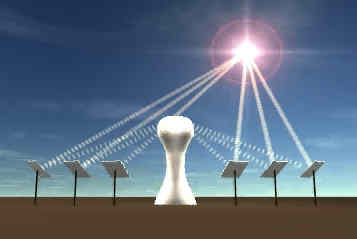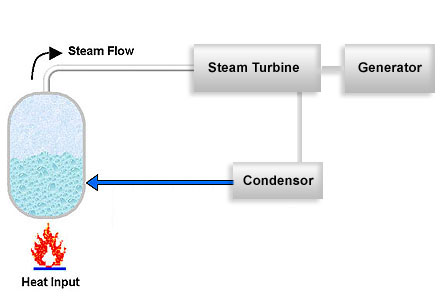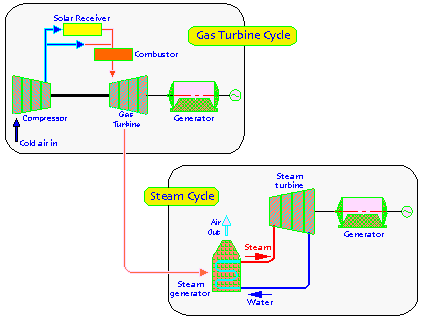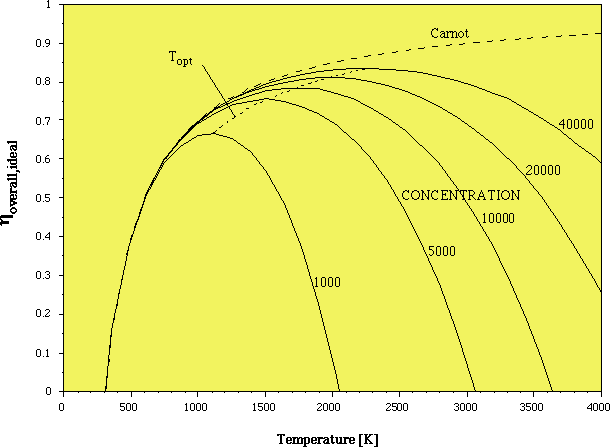Solar Thermal Electricity
 Solar power towers use one central receiver mounted on top of a tower which is surrounded by a field of heliostats - concentrating mirrors which follow the sun. Reflected light is focused onto the receiver and absorbed by the heat transfer medium, which could be sodium, water, molten salt or air. Temperatures of 500-1000 C can be achieved and proposed systems also incorporate energy storage using molten salts. System sizes up to 200MW are possible.
Solar power towers use one central receiver mounted on top of a tower which is surrounded by a field of heliostats - concentrating mirrors which follow the sun. Reflected light is focused onto the receiver and absorbed by the heat transfer medium, which could be sodium, water, molten salt or air. Temperatures of 500-1000 C can be achieved and proposed systems also incorporate energy storage using molten salts. System sizes up to 200MW are possible.
Since water at air temperature will be about 25C, there is a large temperature differential
between the molten salt bucket and the water. Any time two fluids of different temperature
are coupled, energy can be extracted. The larger the temperature difference, the higher
the efficiency. This is how Ocean Thermal Electric Conversion works, which we will be
discussing.

So, basically, the hot fluid is the source of the heat input to the steam
turbine generator.
 In addition, a solar concentrator system can be used in a hybrid capacity
with an existing fossil fuel plant. In this capacity, the solar collector is used as an
additional energy source for heating the cold air to allow it to mix with the natural gas
in the natural gas turbine. This means that less natural gas is needed for the combuster
and there is an overall savings of fuel. This is a particularly viable option when the
price of natural gas is very high. In addition, a solar concentrator system can be used in a hybrid capacity
with an existing fossil fuel plant. In this capacity, the solar collector is used as an
additional energy source for heating the cold air to allow it to mix with the natural gas
in the natural gas turbine. This means that less natural gas is needed for the combuster
and there is an overall savings of fuel. This is a particularly viable option when the
price of natural gas is very high.

The overall efficiency of this system depends
upon temperature of the molten salt fluid and the concentration ratio. With suitably high
temperatures, relatively high efficiency can result. The dashed line called Carnot represents
the maximum theoretical efficiency based on thermodynamics.
There are several advantages to solar thermal electricity generation:
(1) electricity and hot water can be provided at the same time,
(2) plants can be scaled to match the application (up to a point, see below), (3) utilities can match power production to daytime electricity demand peaks, (4) there are few pollutants associated with solar thermal power production, and (5) permits can be issued and plants built in as little as 18 months, far faster than conventional fossil fuel or nuclear plants.
 Note, however, that solar power towers are not infinitely scalable. For capacities larger
than 200 MW, the heliostats have to be located too far away from the tower so that optical/
refraction losses start to become important. In other words, it becomes too difficult to
effectively focus the light from the sun.
However, one could easily make an array of 200 MW units of solar power towers all clustered
together in some desert location.
Note, however, that solar power towers are not infinitely scalable. For capacities larger
than 200 MW, the heliostats have to be located too far away from the tower so that optical/
refraction losses start to become important. In other words, it becomes too difficult to
effectively focus the light from the sun.
However, one could easily make an array of 200 MW units of solar power towers all clustered
together in some desert location.
|

 Note, however, that solar power towers are not infinitely scalable. For capacities larger
than 200 MW, the heliostats have to be located too far away from the tower so that optical/
refraction losses start to become important. In other words, it becomes too difficult to
effectively focus the light from the sun.
However, one could easily make an array of 200 MW units of solar power towers all clustered
together in some desert location.
Note, however, that solar power towers are not infinitely scalable. For capacities larger
than 200 MW, the heliostats have to be located too far away from the tower so that optical/
refraction losses start to become important. In other words, it becomes too difficult to
effectively focus the light from the sun.
However, one could easily make an array of 200 MW units of solar power towers all clustered
together in some desert location.